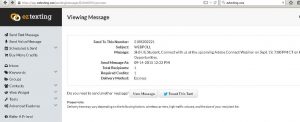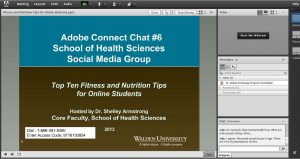Tags: Adobe Connect, Communication, Community of Inquiry, Connectivism, Instructor Presence, Interaction, Social Presence, Synchronous, Text Message
Description
Learning online may be an isolating experience which may lead to student attrition. Digital communication tools may help to enhance online communities of inquiry and address students’ feelings of social connectedness, perceived instructor presence, cognitive engagement, and persistence. Research shows that faculty use of various new media and communication tools (including social media) may foster feelings of community and increase student participation (Brownson, 2014; Hung & Yuen, 2010; Santovec, 2006; Silius, Kailanto & Taervakari, 2011).
This strategy demonstrates how a variety of digital communication tools (e.g. text messaging; synchronous communication tools such as Adobe Connect; and online forums) can be used among an online undergraduate cohort during their first term (and beyond) to enhance online communities of inquiry (COIs), and in turn, students’ feelings of social connectedness, cognitive engagement, persistence, and program satisfaction.
Link to example artifact(s)
The online COI was advertised in an email sent out through student communications to students enrolling in their first term course: Personal Health & Wellness; Introduction to Public Health, or Foundations of Healthcare Management. An announcement was also included in the announcement areas of those foundations courses. Consent forms were obtained electronically, and participants were given the option to “opt in” to the text-messaging tool to receive weekly texts from the program director.
Text Messaging: The platform Eztexting.com was used to provide text messaging services to students who “opted in” to participate in the text messaging service. No identifying information was required, and the program director sent out the messages from her computer. Students could text back, but messages were received on the Eztexting platform in the form of an email. Students received at least 1-2 text messages per week. The text messages consisted of announcements, reminders, health tips, and informational “soundbytes” that would also drive the students to Adobe Connect webinars and the eCampus community.
Adobe Connect Webinars: Adobe Connect was used to host synchronous bi-weekly webinars and conference chats with students on a variety of topics. The majority of topics were chosen based on an interest inventory of topics distributed to students in the eCampus community during the first week of the intervention. University faculty or staff with expertise in these areas helped to facilitate the Adobe Connect webinar/chats which included topics such as: Tips for Success; Everything Undergrad Students Should Know about the Writing Center; Professional Development and Health-Related Career Opportunities; Gaining Field Experience While Studying; Top 10 Fitness and Nutrition Tips for Online Learners; & Improving Financial Health.
eCampus Community: This online platform housed an asynchronous virtual community for COI students, which provided a number of links and resources, such as program of study handouts, career web links, archived Adobe Connect presentations, and discussion forums to connect with other COI students and faculty.
Students feedback indicated that they enjoyed participating in these activities and agree that these activities created a sense of community in their class.
Link to scholarly reference(s)
Boston, W., Diaz, S., Gibson, A., Phil, I., Richardson, J., & Swan, K. (2006). An exploration of the relationship between indicators of the community of inquiry framework and retention inonline programs. Journal of Asynchronous Learning Networks, 13(3), p. 67-83.
Brownson, S. (2014). Embedding social media tools in online learning courses. Journal of Research in Innovative Learning, 7(1), p. 112-118.
Hung, H-T., & Yuen, S. (2010). Educational use of social networking technology in higher education. Teaching in Higher Education, 15(6), 703-714.
Moore, J. C., & Fetzner, M. (2009). The road to retention: A closer look at institutions that achieve high course completion rates. Journal of Asynchronous Learning Networks, 13(3), 3-22.
Santovec, M. L. (2006). Using online networking to engage and retain students. Recruitment and retention in higher education, 20(3), 1.
Silius, K., Kailanto, M., & Tervakari, A-M. (2011). Evaluating the quality of social media in an educational context. International Journal of Emerging Technologies in Learning, 6(3), 21-27.
Walden University. (2012). Student Satisfaction Survey. Office of Institutional Research & Assessment. Laureate Education, Inc.
Warren, M. (2010). Security risks of social networking systems (Keynote Presentation), 4th IEE International Conference on Network and Systems Security, Melbourne, Australia.
Willging, P. A., & Johnson, S. D. (2009) Factors that influence students’ decision to dropout of online courses. Journal of Asynchronous Learning Networks, 13(3), 115-127.
Citation
Armstrong, S. N., Burcin, M. M., & Early, J. (2015). Use digital communication tools to enhance online communities of inquiry. In B. Chen & K. Thompson (Eds.), Teaching Online Pedagogical Repository. Orlando, FL: University of Central Florida Center for Distributed Learning. https://topr.online.ucf.edu/use-digital-communication-tools-to-enhance-online-communities-of-inquiry/?rev=3503.Post Revisions:
- August 11, 2020 @ 17:22:02 [Current Revision]
- August 10, 2020 @ 20:36:58
- September 24, 2018 @ 19:40:50



